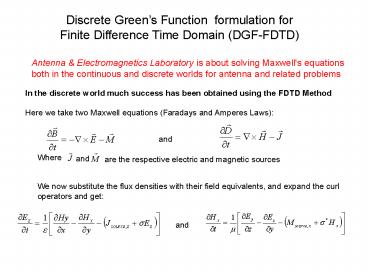Discrete Greens Function formulation for PowerPoint PPT Presentation
1 / 9
Title: Discrete Greens Function formulation for
1
Discrete Greens Function formulation for Finite
Difference Time Domain (DGF-FDTD)
Antenna Electromagnetics Laboratory is about
solving Maxwell's equations both in the
continuous and discrete worlds for antenna and
related problems
In the discrete world much success has been
obtained using the FDTD Method Here we take two
Maxwell equations (Faradays and Amperes Laws)
and
We now substitute the flux densities with their
field equivalents, and expand the curl operators
and get
and
2
The Discretisation Process
The algorithm uses Central differences, and the
following notation is used for a space point in
a uniform rectangular lattice as
A function U of space and time evaluated at a
discrete point in the grid (I,j,k) and at a
discrete point in time(n) as
We now use centred finite-difference expressions
for the space and time derivatives, these are
second order accurate
3
The FDTD Algorithm
We now apply Yees algorithm, here the electric
and magnetic fields are interleaved forming a
volume of discrete nodes (magnetic and electric)
which have to be calculated regardless of their
respective importance. They are then calculated
so that the code time steps between the two
fields
So
and
Transforms to-
4
The FDTD Grid
GRID
YEES ALGORITHUM
5
For big problems discretise the Greens Function
approach that has been so successful in the
continuous world
DGF-FDTD Method
DGF-FDTD results in a method in which the
interactions of elements is action at a distance,
this Therefore dispenses with the costly need to
calculate a volume of nodes.
Discrete system theory is applied to the Yee time
stepping equations within the Formulation of
DGF-FDTD. This is too complex for a detailed
treatment here, however certain areas of the
formulation causing particular concern can be
discussed.
6
DGF-FDTD Areas of Concern
A Kronecker delta is used to excite the FDTD
system and so get the impulse response, this
advantageously has the benefit of being very easy
to work with mathematically. It does however
create a Greens function with a very broad
spectral content, which is not in the interests
of an efficient code. The formulation of the
DGF-FDTD is expressed as a Jacobi polynomial, the
advantage of this is that it makes further
mathematical manipulation easier. It does however
require the computation of high order
polynomials The practical application of the
DGF-FDTD code is very sensitive to numerical
error.
7
Results
Far-Field Radiation Pattern of Half-wave dipole
at 3.0GHz
8
Results (Cont.)
Far-Field Radiation Pattern of A two element
array of half wave dipoles, spaced half a
wavelength apart at 3.0GHz
9
Future Challenges
Inclusion of other materials especially
dielectrics.
Development of the Greens function with a
limited bandwidth function replacing the delta
function. Loss of convenient properties of the
delta function Efficient and accurate
computation of high order polynomials and
factorials. More imaginative use of Transform
techniques to reduce large number numerical error
Hybridisation with classic FDTD so that complex
sources can be modelled by a core FDTD code,
and the outer regions by the more efficient
DGF-FDTD.

